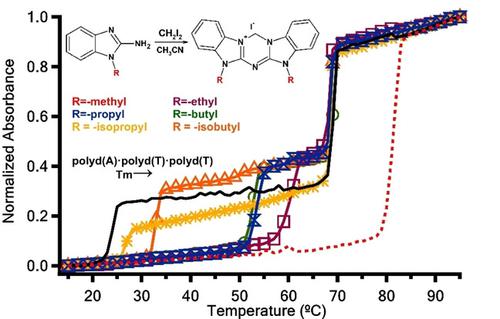当前位置:
X-MOL 学术
›
ChemistrySelect
›
论文详情
Our official English website, www.x-mol.net, welcomes your
feedback! (Note: you will need to create a separate account there.)
Selective High Binding Affinity of Azacyanines to polyd(A) polyd(T)⋅polyd(T) Triplex: The Effect of Chain Length and Branching on Stabilization, Selectivity and Affinity
ChemistrySelect ( IF 1.9 ) Pub Date : 2018-12-05 , DOI: 10.1002/slct.201802802 Serra Tutuncu 1 , Sercan Guloglu 2 , Ayca Kucukakdag 3 , Ozgul Persil Cetinkol 1, 2, 3
ChemistrySelect ( IF 1.9 ) Pub Date : 2018-12-05 , DOI: 10.1002/slct.201802802 Serra Tutuncu 1 , Sercan Guloglu 2 , Ayca Kucukakdag 3 , Ozgul Persil Cetinkol 1, 2, 3
Affiliation

|
Triplex nucleic acid structures receive considerable attention due to their possible role in anti‐gene therapy, several diseases as Friedreich's ataxia and Deoxyribonucleic acid (DNA) based nano‐structures. The modulation of triplex formation and its stabilization using small molecules is one way to enhance their utility in such applications. Here, we synthesized five new Azacyanines (Azaethyl (2 b), Azapropyl (2 c), Azaisopropyl (2 d), Azabutyl (2 e), Azaisobutyl (2 f)) and assessed their affinity and selectivity towards polyd(A), polyd(T), polyd(A)⋅polyd(T) and polyd(A)⋅polyd(T)⋅polyd(T) along with the previously synthesized Azamethyl (2 a). Our UV‐Vis, CD and competition dialysis results revealed that Azacyanines were selective towards polyd(A)⋅polyd(T)⋅polyd(T) triplex. They were stabilizing triplex structure to different degrees, the degree of stabilization being dependent on the alkyl chain length and branching on the benzimidazole ring. Thermal denaturation temperature of the triplex in the presence of Azacyanines was increasing in order: Azamethyl (2 a) > Azaethyl (2 b) > Azapropyl (2 c) > Azabutyl (2 e)> Azaisobutyl (2 f) > Azaisopropyl (2 d). Our results also demonstrate that, Azamethyl (2 a) was able to disproportionate polyd(A)⋅polyd(T) into intercalated polyd(A)⋅polyd(T)⋅polyd(T) complex.
中文翻译:

花青素对polyd(A)polyd(T)⋅polyd(T)Triplex的选择性高结合亲和力:链长和支化对稳定度,选择性和亲和力的影响
三联体核酸结构由于其在抗基因治疗中的作用而备受关注,这是多种疾病,如Friedreich共济失调和基于脱氧核糖核酸(DNA)的纳米结构。使用小分子调节三链体的形成及其稳定性是增强其在此类应用中的效用的一种方法。在这里,我们合成了五种新的氮杂花青素(氮杂乙基(2 b),氮杂丙基(2 c),氮杂异丙基(2 d),氮杂丁基(2 e),氮杂异丁基(2 f)),并评估了它们对聚d(A)的亲和力和选择性, polyd(T),polyd(A)⋅polyd(T)和polyd(A)⋅polyd(T)⋅polyd(T)以及先前合成的氮杂甲基(2 a)。我们的UV-Vis,CD和竞争性透析结果表明,花青素对polyd(A)·polyd(T)·polyd(T)三元组具有选择性。它们在不同程度上稳定三链体结构,稳定程度取决于烷基链长度和苯并咪唑环上的支链。在Azacyanines的存在下,三链的热变性温度,是为了增加:Azamethyl(2)> Azaethyl(2 B)> Azapropyl(2 C)> Azabutyl(图2e)> Azaisobutyl(2 F)> Azaisopropyl(2 d)。我们的结果还表明,氮杂甲基(2 a)能够将polyd(A)·polyd(T)歧化为插层的polyd(A)·polyd(T)·polyd(T)络合物。
更新日期:2018-12-05
中文翻译:

花青素对polyd(A)polyd(T)⋅polyd(T)Triplex的选择性高结合亲和力:链长和支化对稳定度,选择性和亲和力的影响
三联体核酸结构由于其在抗基因治疗中的作用而备受关注,这是多种疾病,如Friedreich共济失调和基于脱氧核糖核酸(DNA)的纳米结构。使用小分子调节三链体的形成及其稳定性是增强其在此类应用中的效用的一种方法。在这里,我们合成了五种新的氮杂花青素(氮杂乙基(2 b),氮杂丙基(2 c),氮杂异丙基(2 d),氮杂丁基(2 e),氮杂异丁基(2 f)),并评估了它们对聚d(A)的亲和力和选择性, polyd(T),polyd(A)⋅polyd(T)和polyd(A)⋅polyd(T)⋅polyd(T)以及先前合成的氮杂甲基(2 a)。我们的UV-Vis,CD和竞争性透析结果表明,花青素对polyd(A)·polyd(T)·polyd(T)三元组具有选择性。它们在不同程度上稳定三链体结构,稳定程度取决于烷基链长度和苯并咪唑环上的支链。在Azacyanines的存在下,三链的热变性温度,是为了增加:Azamethyl(2)> Azaethyl(2 B)> Azapropyl(2 C)> Azabutyl(图2e)> Azaisobutyl(2 F)> Azaisopropyl(2 d)。我们的结果还表明,氮杂甲基(2 a)能够将polyd(A)·polyd(T)歧化为插层的polyd(A)·polyd(T)·polyd(T)络合物。











































 京公网安备 11010802027423号
京公网安备 11010802027423号